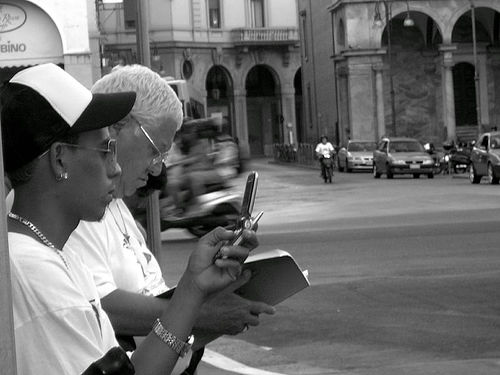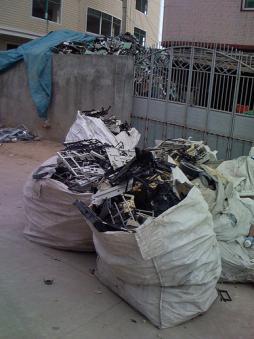GSMA
Posted by KatrinVerclas on Jan 24, 2007
 I am part of a research project for the Gates Foundation on the future of global online advocacy, where I have been adding data and commentary on mobile content. One of the ideas we have floated is a global SMS hub – a commercial aggregator for low cost global SMS campaigns.
I am part of a research project for the Gates Foundation on the future of global online advocacy, where I have been adding data and commentary on mobile content. One of the ideas we have floated is a global SMS hub – a commercial aggregator for low cost global SMS campaigns.
Why is this needed?
SMS is a critical tool for e-advocacy in the global south. Given the high rates of mobile phone penetration in large parts of the world compared to Internet access, SMS allows a much wider reach than email. However, mass SMS campaigns are not feasible option for many NGOs in the global south because of cost – costs that pertain both to the NGO itself and to potential campaign participants who must pay to text. Sending an email message (or a thousand) entails no excess cost for an NGO above the cost of an internet connection (which admittedly, can be formidable in some parts of the world). However, if an NGO sends an SMS, it must pay per message (the global average cost is .10 US $), making mass texting thousands of messages prohibitively expensive. In addition, SMS is in some countries still relatively expensive for consumers, making it somewhat unlikely that they would send an SMS message on behalf of an advocacy campaign.
What would reduce the cost of SMS for social causes and allow for mass sms campaigns to become a reality for NGOs engaging their constituents?
What is needed is a global SMS hub for civil society organizations, and possibly even one with toll-free numbers for SMS that would not charge participants. With a toll-free SMS short code, the sender would not have to pay to send the SMS to a particular number or better yet short code. This would require short code requisition for many countries and agreements with all telephone operator in the country (or countries) in which the service is to be offered -- short, a global aggregator service with a twist, a Clickatell for Good.
How far off from being a reality is a global SMS hub for civil society?
The GSM Association recently completed trials of a hub-baed interoperability structure. From it’s press release:
Posted by MarkWeingarten on Feb 21, 2011
Women & Mobile - A Global Opportunity: A Study on the Mobile Phone Gender Gap in Low and Middle-income Countries data sheet 1981 Views
Abstract:
Mobile Phone ownership in low and middle-income countries has skyrocketed in the past several years. But a woman is still 21% less likely to own a mobile phone than a man. This figure increases to 23% if she lives in Africa, and 37% if she lives in South Asia. Closing this gender gap would bring the benefit of mobile phones to an additional 300 million women. By extending the benefits of mobile phone ownership to women, a host of social and economic goals can be advanced.
Mobile phone ownership provides distinct benefits to women, including improved access to educational, health, business and employment opportunities. Women surveyed across low and middle-incoome countries on three continents believe that a mobile phone helps them lead a more secure, connected and productive life.
Posted by MohiniBhavsar on Jun 29, 2010
Counting Mobile Phones, SIM Cards and Customers data sheet 1751 Views
Abstract:
The GMSA reports that the mobile subscriptions worldwide is at 3 billion (2008) with 270 million subscriptions in Africa at the end of 2007. This policy paper considers the challenges faced by public policy makers in understanding the true number of individuals with mobile access. There are many reasons why customers might have more than one phone, phone number or SIM card, which results in the double-counting of customers. As a result, it is difficult to assume that the number telephone numbers or SIM cards translates into individual customers. The author discusses the issue of ambiguity in the estimates of mobile teledensity as an indicator for the MDGs and the subsequent challenge for public policy makers in interpreting the large numbers and how they reflect the reality of their countries, cities, towns and villages. Case studies in Bulgaria and South Africa are presented.
Posted by AnneryanHeatwole on Mar 03, 2010
The United Nations Environment Programme has released a new study on managing e-waste for developing countries. The report focuses one three major points: the market potential of e-waste recycling, encouraging the adoption of the UNEP’s guidelines to foster innovation in e-waste recycling technologies, and identifying places in which e-waste recycling is thriving.
The study acknowledges that data of e-waste is insufficient, but the United Nations University estimates “that current e-waste arising across the twenty-seven members of the European Usnion amount to around 8.3 – 9.1 million per year; global arising are estimated to be around 40 million tons per year.”
The report used data from 11 representative developing countries to estimate current and future e-waste generation - which includes old and dilapidated desk and laptop computers, printers, mobile phones, pagers, digital photo and music devices, refrigerators, toys and televisions.
Posted by AnneryanHeatwole on Feb 19, 2010
Women and Mobile: A Global Opportunity data sheet 2479 Views
Author:
GSMA, Cherie Blair Foundation for Women, Vital Wave Consulting, women, mobile ownership, access to telecommunications, poverty, gender gap
Abstract:
Mobile phone ownership in low and middle-income countries has skyrocketed in the past several years. But a woman is still 21% less likely to own a mobile phone than a man. This figure increases to 23% if she lives in Africa, 24% if she lives in the Middle East, and 37% if she lives in South Asia. Closing this gender gap would bring the benefits of mobile phones to an additional 300 million women. By extending the benefits of mobile phone ownership to more women, a host of social and economic goals can be advanced.
Mobile phone ownership provides distinct benefits to women, including improved access to educational, health, business and employment opportunities. Women surveyed across low and middle-income countries on three continents believe that a mobile phone helps them lead a more secure, connected and productive life.
Posted by AnneryanHeatwole on Nov 03, 2009
What Makes a Successful Mobile Money Implementation? Learnings from M-PESA in Kenya and Tanzania data sheet 4351 Views
Author:
Gunnar Camner, Emil Sjoblom, Caroline Pulver
Abstract:
This review considers the differences between the adoption rates of M-PESA in Kenya and Tanzania and tries to highlight some of the reasons that the same service launched in seemingly similar countries has yielded such different results. This paper is intended as a discussion document for mobile network operators considering launching a mobile money service.
Safaricom launched M-PESA in Kenya in March 2007 and has since become the most famous and probably the most successful implementation of mobile money service to date. In May 2008, 14 months after the launch, M-PESA in Kenya had 2.7 million users and almost 3,000 agents. Today, over two years since its launch, M-PESA has gained 7 million registered customers and has 10,000 agents spread across the country. This exceeds the reach of any other financial service in Kenya.
Finaccess 2009 showed that M-PESA has become the most popular method of money transfer in Kenya with 40% of all adults using the service. The same Kenyan survey also shows a dramatic increase in national remittances; from 17% in 2006 to 52% in 2009, which may be attributed to the ease of money transfer through ubiquitous M-PESA agents. Many mobile network operators have been eager to repeat M-PESA’s success in Kenya, but the formula for this success is not yet clear. One year after the Kenyan launch, Vodacom launched M-PESA in April 2008 in Tanzania. The user uptake of the service in Tanzania has been much slower compared to its northern neighbour. In June 2009, 14 months after the launch, M-PESA in Tanzania had 280,000 users and 1,000 agents (Rasmussen 2009).
Posted by AnneryanHeatwole on Nov 02, 2009
Global Mobile Tax Review data sheet 2450 Views
Abstract:
In 2005, the GSM Association (GSMA) developed its first study on tax and the digital divide, seeking to understand more fully the tax rates affecting telecommunications in developing countries and the impact that cutting taxes may have on mobile handsets and new services. The study’s key findings showed that telecommunication taxes were disproportionately high in many developing countries and that even small cuts in taxes many attract significantly more mobile users. In this second report, the analysis is extended to include a larger set of countries – in particular adding transitional Eastern European countries. The report also investigates more fully the link between lower taxes and revenue opportunities for governments in the long term, showing that cutting taxes may lead to increased economic growth in the least developed countries.
 I am part of a research project for the Gates Foundation on the future of global online advocacy, where I have been adding data and commentary on mobile content. One of the ideas we have floated is a global SMS hub – a commercial aggregator for low cost global SMS campaigns.
I am part of a research project for the Gates Foundation on the future of global online advocacy, where I have been adding data and commentary on mobile content. One of the ideas we have floated is a global SMS hub – a commercial aggregator for low cost global SMS campaigns. 
